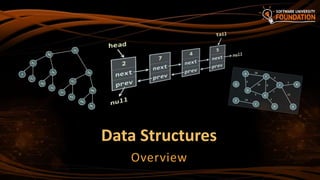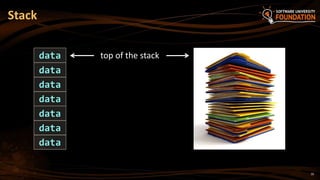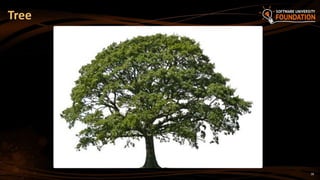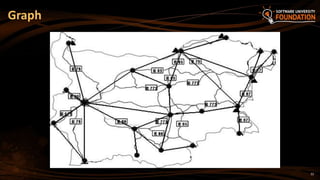19. Java data structures algorithms and complexity
- 1. SoftUni Team Technical Trainers Software University http://softuni.bg Data Structures, Algorithms and Complexity Analyzing Algorithm Complexity. Asymptotic Notation
- 2. Table of Contents 1. Data Structures Linear Structures, Trees, Hash Tables, Others 2. Algorithms Sorting and Searching, Combinatorics, Dynamic Programming, Graphs, Others 3. Complexity of Algorithms Time and Space Complexity Mean, Average and Worst Case Asymptotic Notation O(g) 2
- 3. 3
- 4. 4
- 6. 6 Examples of data structures: Person structure (first name + last name + age) Array of integers – int[] List of strings – List<string> Queue of people – Queue<Person> What is a Data Structure? “In computer science, a data structure is a particular way of storing and organizing data in a computer so that it can be used efficiently.” -- Wikipedia
- 7. 7 Student Data Structure struct Student { string Name { get; set; } short Age { get; set; } // Student age (< 128) Gender Gender { get; set; } int FacultyNumber { get; set; } }; enum Gender { Male, Female, Other } Student Name Maria Smith Age 23 Gender Female FacultyNumber SU2007333
- 8. 8 Stack
- 9. 9 Stack class Stack<T> { // Pushes an elements at the top of the stack void Push(T data); // Extracts the element at the top of the stack T Pop(); // Checks for empty stack bool IsEmpty(); } // The type T can be any data structure like // int, string, DateTime, Student
- 11. 11 Queue
- 12. 12 Queue
- 13. 13 Queue
- 14. 14 Queue
- 15. 15 Queue class Queue<T> { // Appends an elements at the end of the queue void Enqueue(T data); // Extracts the element from the start of the queue T Dequeue(); // Checks for empty queue bool IsEmpty(); } // The type T can be any data structure like // int, string, DateTime, Student
- 16. 16 Queue data data data data data data data Start of the queue: elements are excluded from this position End of the queue: new elements are inserted here
- 18. 18 Tree
- 19. 19 Trees 17 15149 6 5 8 Project Manager Team Leader De- signer QA Team Leader Developer 1 Developer 2 Tester 1 Developer 3 Tester 2
- 20. 20 Binary Tree data left link ....... NULL tree root right link data left link right link data left link right link data left link right link data left link right link ....... NULL NULL ....... .......
- 21. 21 Graph
- 22. 22 Graph
- 23. 23 Graphs 7 19 21 14 1 12 31 4 11 G J F D A E C H GA H N K
- 24. 24 Hash-Table
- 25. 25 Hash-Table: Structure Key1 Element1 … Hash-Function Slot 0 …… Slot 1 Slot 2 Slot Key 2 Element 2 Key m Element m n-1
- 26. 26 Hash-Table: Chaining on Collision NULL 234 0 1 2 3 8 9 4 5 6 7 235 567 647 534 NULL NULL NULL NULL NULL NULL NULL NULL 123 NULL
- 27. 27 Data structures and algorithms are the foundation of computer programming Algorithmic thinking, problem solving and data structures are vital for software engineers C# developers should know when to use T[], LinkedList<T>, List<T>, Stack<T>, Queue<T>, Dictionary<K, T>, HashSet<T>, SortedDictionary<K, T> and SortedSet<T> Computational complexity is important for algorithm design and efficient programming Why Are Data Structures So Important?
- 28. Primitive data types Numbers: int, float, double, decimal, … Text data: char, string, … Simple structures A group of primitive fields stored together E.g. DateTime, Point, Rectangle, Color, … Collections A set / sequence of elements (of the same type) E.g. array, list, stack, queue, tree, hashtable, bag, … Primitive Types and Collections
- 29. An Abstract Data Type (ADT) is A data type together with the operations, whose properties are specified independently of any particular implementation ADT is a set of definitions of operations Like the interfaces in C# / Java Defines what we can do with the structure ADT can have several different implementations Different implementations can have different efficiency, inner logic and resource needs Abstract Data Types (ADT)
- 30. Linear structures Lists: fixed size and variable size sequences Stacks: LIFO (Last In First Out) structures Queues: FIFO (First In First Out) structures Trees and tree-like structures Binary, ordered search trees, balanced trees, etc. Dictionaries (maps, associative arrays) Hold pairs (key value) Hash tables: use hash functions to search / insert Basic Data Structures
- 31. 31 Sets, multi-sets and bags Set – collection of unique elements Bag – collection of non-unique elements Ordered sets and dictionaries Priority queues / heaps Special tree structures Suffix tree, interval tree, index tree, trie, rope, … Graphs Directed / undirected, weighted / unweighted, connected / non-connected, cyclic / acyclic, … Basic Data Structures (2)
- 33. 33 The term "algorithm" means "a sequence of steps" Derived from Muḥammad Al-Khwārizmī', a Persian mathematician and astronomer He described an algorithm for solving quadratic equations in 825 What is an Algorithm? “In mathematics and computer science, an algorithm is a step-by-step procedure for calculations. An algorithm is an effective method expressed as a finite list of well- defined instructions for calculating a function.” -- Wikipedia
- 34. 34 Algorithms are fundamental in programming Imperative (traditional, algorithmic) programming means to describe in formal steps how to do something Algorithm == sequence of operations (steps) Can include branches (conditional blocks) and repeated logic (loops) Algorithmic thinking (mathematical thinking, logical thinking, engineering thinking) Ability to decompose the problems into formal sequences of steps (algorithms) Algorithms in Computer Science
- 35. 35 Algorithms can be expressed as pseudocode, through flowcharts or program code Pseudocode and Flowcharts BFS(node) { queue node while queue not empty v queue print v for each child c of v queue c } Pseudo-code Flowchart public void DFS(Node node) { Print(node.Name); for (int i = 0; i < node. Children.Count; i++) { if (!visited[node.Id]) DFS(node.Children[i]); } visited[node.Id] = true; } Source code
- 36. Sorting and searching Dynamic programming Graph algorithms DFS and BFS traversals Combinatorial algorithms Recursive algorithms Other algorithms Greedy algorithms, computational geometry, randomized algorithms, parallel algorithms, genetic algorithms 36 Some Algorithms in Programming
- 38. 38
- 39. 39 Why should we analyze algorithms? Predict the resources the algorithm will need Computational time (CPU consumption) Memory space (RAM consumption) Communication bandwidth consumption The expected running time of an algorithm is: The total number of primitive operations executed (machine independent steps) Also known as algorithm complexity Algorithm Analysis
- 40. 40 What to measure? CPU time Memory consumption Number of steps Number of particular operations Number of disk operations Number of network packets Asymptotic complexity Algorithmic Complexity
- 41. 41 Worst-case An upper bound on the running time for any input of given size Typically algorithms performance is measured for their worst case Average-case The running time averaged over all possible inputs Used to measure algorithms that are repeated many times Best-case The lower bound on the running time (the optimal case) Time Complexity
- 42. Sequential search in a list of size n Worst-case: n comparisons Best-case: 1 comparison Average-case: n/2 comparisons The algorithm runs in linear time Linear number of operations 42 Time Complexity: Example … … … … … … … n
- 44. 44 Warning: Math Can be Hard!
- 45. 45 Algorithm complexity is a rough estimation of the number of steps performed by given computation, depending on the size of the input Measured with asymptotic notation O(g) where g is a function of the size of the input data Examples: Linear complexity O(n) All elements are processed once (or constant number of times) Quadratic complexity O(n2) Each of the elements is processed n times Algorithms Complexity
- 46. 46 Asymptotic upper bound O-notation (Big O notation) For a given function g(n), we denote by O(g(n)) the set of functions that are different than g(n) by a constant Examples: 3 * n2 + n/2 + 12 ∈ O(n2) 4*n*log2(3*n+1) + 2*n-1 ∈ O(n * log n) Asymptotic Notation: Definition O(g(n)) = {f(n): there exist positive constants c and n0 such that f(n) <= c*g(n) for all n >= n0}
- 49. 49 Complexity Notation Description constant O(1) Constant number of operations, not depending on the input data size, e.g. n = 1 000 000 1-2 operations logarithmic O(log n) Number of operations proportional to log2(n) where n is the size of the input data, e.g. n = 1 000 000 000 30 operations linear O(n) Number of operations proportional to the input data size, e.g. n = 10 000 5 000 operations Typical Complexities
- 50. 50 Complexity Notation Description quadratic O(n2) Number of operations proportional to the square of the size of the input data, e.g. n = 500 250 000 operations cubic O(n3) Number of operations propor-tional to the cube of the size of the input data, e.g. n = 200 8 000 000 operations exponential O(2n), O(kn), O(n!) Exponential number of operations, fast growing, e.g. n = 20 1 048 576 operations Typical Complexities (2)
- 52. 52 Time Complexity and Program Speed Complexity 10 20 50 100 1 000 10 000 100 000 O(1) < 1 s < 1 s < 1 s < 1 s < 1 s < 1 s < 1 s O(log(n)) < 1 s < 1 s < 1 s < 1 s < 1 s < 1 s < 1 s O(n) < 1 s < 1 s < 1 s < 1 s < 1 s < 1 s < 1 s O(n*log(n)) < 1 s < 1 s < 1 s < 1 s < 1 s < 1 s < 1 s O(n2) < 1 s < 1 s < 1 s < 1 s < 1 s 2 s 3-4 min O(n3) < 1 s < 1 s < 1 s < 1 s 20 s 5 hours 231 days O(2n) < 1 s < 1 s 260 days hangs hangs hangs hangs O(n!) < 1 s hangs hangs hangs hangs hangs hangs O(nn) 3-4 min hangs hangs hangs hangs hangs hangs
- 53. 53
- 54. 54 Complexity can be expressed as a formula of multiple variables, e.g. Algorithm filling a matrix of size n * m with the natural numbers 1, 2, … n*m will run in O(n*m) Algorithms to traverse a graph with n vertices and m edges will take O(n + m) steps Memory consumption should also be considered, for example: Running time O(n) & memory requirement O(n2) n = 50 000 OutOfMemoryException Time and Memory Complexity BTW: Is it possible in practice? In theory?
- 56. 56 A linear algorithm could be slower than a quadratic algorithm The hidden constant could be significant Example: Algorithm A performs 100*n steps O(n) Algorithm B performs n*(n-1)/2 steps O(n2) For n < 200, algorithm B is faster Real-world example: The "insertion sort" is faster than "quicksort" for n < 9 The Hidden Constant
- 57. 57 Amortized Analysis Worst case: O(n2) Average case: O(n) – Why? void AddOne(char[] chars, int m) { for (int i = 0; 1 != chars[i] && i < m; i++) { c[i] = 1 - c[i]; } }
- 58. 58 Complexity: O(n3) Using Math sum = 0; for (i = 1; i <= n; i++) { for (j = 1; j <= i*i; j++) { sum++; } }
- 59. 59 Just calculate and print sum = n * (n + 1) * (2n + 1) / 6 Using a Barometer uint sum = 0; for (i = 0; i < n; i++) { for (j = 0; j < i*i; j++) { sum++; } } Console.WriteLine(sum);
- 60. 60 A polynomial-time algorithm has worst-case time complexity bounded above by a polynomial function of its input size Examples: Polynomial time: 2n, 3n3 + 4n Exponential time: 2n, 3n, nk, n! Exponential algorithms hang for large input data sets Polynomial Algorithms W(n) ∈ O(p(n))
- 61. 61 Computational complexity theory divides the computational problems into several classes: Computational Classes
- 62. 62 P vs. NP: Problem #1 in Computer Science Today
- 63. Analyzing the Complexity of Algorithms Examples
- 64. Runs in O(n) where n is the size of the array The number of elementary steps is ~ n Complexity Examples int FindMaxElement(int[] array) { int max = array[0]; for (int i=1; i<array.length; i++) { if (array[i] > max) { max = array[i]; } } return max; }
- 65. Runs in O(n2) where n is the size of the array The number of elementary steps is ~ n * (n+1) / 2 Complexity Examples (2) long FindInversions(int[] array) { long inversions = 0; for (int i=0; i<array.Length; i++) for (int j = i+1; j<array.Length; i++) if (array[i] > array[j]) inversions++; return inversions; }
- 66. Runs in cubic time O(n3) The number of elementary steps is ~ n3 Complexity Examples (3) decimal Sum3(int n) { decimal sum = 0; for (int a=0; a<n; a++) for (int b=0; b<n; b++) for (int c=0; c<n; c++) sum += a*b*c; return sum; }
- 67. Runs in quadratic time O(n*m) The number of elementary steps is ~ n*m Complexity Examples (4) long SumMN(int n, int m) { long sum = 0; for (int x=0; x<n; x++) for (int y=0; y<m; y++) sum += x*y; return sum; }
- 68. Runs in quadratic time O(n*m) The number of elementary steps is ~ n*m + min(m,n)*n Complexity Examples (5) long SumMN(int n, int m) { long sum = 0; for (int x=0; x<n; x++) for (int y=0; y<m; y++) if (x==y) for (int i=0; i<n; i++) sum += i*x*y; return sum; }
- 69. Runs in exponential time O(2n) The number of elementary steps is ~ 2n Complexity Examples (6) decimal Calculation(int n) { decimal result = 0; for (int i = 0; i < (1<<n); i++) result += i; return result; }
- 70. Runs in linear time O(n) The number of elementary steps is ~ n Complexity Examples (7) decimal Factorial(int n) { if (n==0) return 1; else return n * Factorial(n-1); }
- 71. Runs in exponential time O(2n) The number of elementary steps is ~ Fib(n+1) where Fib(k) is the kth Fibonacci's number Complexity Examples (8) decimal Fibonacci(int n) { if (n == 0) return 1; else if (n == 1) return 1; else return Fibonacci(n-1) + Fibonacci(n-2); }
- 72. Lab Exercise Calculating Complexity of Existing Code
- 78. 78 Data structures organize data in computer systems for efficient use Abstract data types (ADT) describe a set of operations Collections hold a group of elements Algorithms are sequences of steps for calculating / doing something Algorithm complexity is a rough estimation of the number of steps performed by given computation Can be logarithmic, linear, n log n, square, cubic, exponential, etc. Complexity predicts the speed of given code before its execution Summary
- 79. 79
- 80. ? https://softuni.bg/trainings/1147/Data-Structures-June-2015 Data Structures, Algorithms and Complexity
- 81. License This course (slides, examples, labs, videos, homework, etc.) is licensed under the "Creative Commons Attribution- NonCommercial-ShareAlike 4.0 International" license 81 Attribution: this work may contain portions from "Fundamentals of Computer Programming with C#" book by Svetlin Nakov & Co. under CC-BY-SA license "Data Structures and Algorithms" course by Telerik Academy under CC-BY-NC-SA license
- 82. Free Trainings @ Software University Software University Foundation – softuni.org Software University – High-Quality Education, Profession and Job for Software Developers softuni.bg Software University @ Facebook facebook.com/SoftwareUniversity Software University @ YouTube youtube.com/SoftwareUniversity Software University Forums – forum.softuni.bg
Editor's Notes
- #40: 39##
- #41: 40##
- #42: 41##
- #43: 42##
- #47: 46##
- #61: 60##
- #64: 63##
- #65: 64##
- #66: 65##
- #67: 66##
- #68: 67##
- #69: 68##
- #70: 69##
- #71: 70##
- #72: 71##
- #79: (c) 2007 National Academy for Software Development - http://academy.devbg.org. All rights reserved. Unauthorized copying or re-distribution is strictly prohibited.*






![6
Examples of data structures:
Person structure (first name + last name + age)
Array of integers – int[]
List of strings – List<string>
Queue of people – Queue<Person>
What is a Data Structure?
“In computer science, a data structure is a particular
way of storing and organizing data in a computer so
that it can be used efficiently.” -- Wikipedia](https://image.slidesharecdn.com/1-200321144419/85/19-Java-data-structures-algorithms-and-complexity-6-320.jpg)




















![27
Data structures and algorithms are the foundation of computer
programming
Algorithmic thinking, problem solving and data structures are
vital for software engineers
C# developers should know when to use T[], LinkedList<T>,
List<T>, Stack<T>, Queue<T>, Dictionary<K, T>,
HashSet<T>, SortedDictionary<K, T> and SortedSet<T>
Computational complexity is important for algorithm design and
efficient programming
Why Are Data Structures So Important?](https://image.slidesharecdn.com/1-200321144419/85/19-Java-data-structures-algorithms-and-complexity-27-320.jpg)







![35
Algorithms can be expressed as pseudocode, through flowcharts or
program code
Pseudocode and Flowcharts
BFS(node)
{
queue node
while queue not empty
v queue
print v
for each child c of v
queue c
}
Pseudo-code Flowchart
public void DFS(Node node)
{
Print(node.Name);
for (int i = 0; i < node.
Children.Count; i++)
{
if (!visited[node.Id])
DFS(node.Children[i]);
}
visited[node.Id] = true;
}
Source code](https://image.slidesharecdn.com/1-200321144419/85/19-Java-data-structures-algorithms-and-complexity-35-320.jpg)





















![57
Amortized Analysis
Worst case: O(n2)
Average case: O(n) – Why?
void AddOne(char[] chars, int m)
{
for (int i = 0; 1 != chars[i] && i < m; i++)
{
c[i] = 1 - c[i];
}
}](https://image.slidesharecdn.com/1-200321144419/85/19-Java-data-structures-algorithms-and-complexity-57-320.jpg)






![ Runs in O(n) where n is the size of the array
The number of elementary steps is ~ n
Complexity Examples
int FindMaxElement(int[] array)
{
int max = array[0];
for (int i=1; i<array.length; i++)
{
if (array[i] > max)
{
max = array[i];
}
}
return max;
}](https://image.slidesharecdn.com/1-200321144419/85/19-Java-data-structures-algorithms-and-complexity-64-320.jpg)
![ Runs in O(n2) where n is the size of the array
The number of elementary steps is ~ n * (n+1) / 2
Complexity Examples (2)
long FindInversions(int[] array)
{
long inversions = 0;
for (int i=0; i<array.Length; i++)
for (int j = i+1; j<array.Length; i++)
if (array[i] > array[j])
inversions++;
return inversions;
}](https://image.slidesharecdn.com/1-200321144419/85/19-Java-data-structures-algorithms-and-complexity-65-320.jpg)



































































































